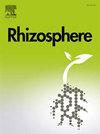Toxicological assessment and biodegradation of imidacloprid by dominant strain LBb2 and their impact on soil microbial communities
IF 3.4
3区 生物学
Q1 PLANT SCIENCES
引用次数: 0
Abstract
The extended application of neonicotinoid insecticides for agricultural use has resulted in excessive levels of imidacloprid entering soil environments, surpassing the natural self-purification capacity of the soil and posing threats to human health and ecosystems. This study isolated an efficient imidacloprid-degrading strain, LBb2, through selective enrichment and domestication. The strain was taxonomically identified as Bacillus proteolyticus. Optimal degradation conditions for 100 mg/L of imidacloprid were determined using response surface methodology, with a pH of 6.4, a temperature of 31 °C, and an inoculation size of 7.5%, achieving a degradation rate of 53.20% after 7 days. Toxicological analysis of imidacloprid and its metabolites revealed that imidacloprid affects seed germination and development, inhibits Escherichia coli growth, and induces micronucleus formation in faba seeds. Metabolite analysis indicated that the main metabolic pathways of imidacloprid were hydroxylation to form IM-6 and nitro-reduction to form IM-1, both of which could be further degraded to 6-CNA. The relative abundances of some phyla and genera appeared to have risen in soils treated with imidacloprid and LBb2, for instance Actinomyceta, Ascomycota, Sphingomonas, Microvirga. In contrast, the relative abundances of some phyla and genera decreased, such as Acidobacteria, Chloroflexi, Mortierella, Mycosphaerella. This research presents a theoretical foundation to assess biological risk of imidacloprid and for further use of microbial contamination remediation of pesticide contamination, and offers significant guidance for sustainable agricultural development, soil pollution remediation, and the rational use of pesticides. The future research direction can explore the synergistic effect of LBb2 with other strains to improve the degradation effect.

求助全文
约1分钟内获得全文
求助全文
来源期刊

Rhizosphere
Agricultural and Biological Sciences-Agronomy and Crop Science
CiteScore
5.70
自引率
8.10%
发文量
155
审稿时长
29 days
期刊介绍:
Rhizosphere aims to advance the frontier of our understanding of plant-soil interactions. Rhizosphere is a multidisciplinary journal that publishes research on the interactions between plant roots, soil organisms, nutrients, and water. Except carbon fixation by photosynthesis, plants obtain all other elements primarily from soil through roots.
We are beginning to understand how communications at the rhizosphere, with soil organisms and other plant species, affect root exudates and nutrient uptake. This rapidly evolving subject utilizes molecular biology and genomic tools, food web or community structure manipulations, high performance liquid chromatography, isotopic analysis, diverse spectroscopic analytics, tomography and other microscopy, complex statistical and modeling tools.
 求助内容:
求助内容: 应助结果提醒方式:
应助结果提醒方式:


